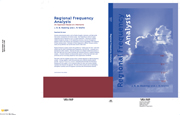Book contents
- Frontmatter
- Contents
- Preface
- Errata
- Chapter 1 Regional frequency analysis
- Chapter 2 L-moments
- Chapter 3 Screening the data
- Chapter 4 Identification of homogeneous regions
- Chapter 5 Choice of a frequency distribution
- Chapter 6 Estimation of the frequency distribution
- Chapter 7 Performance of the regional L-moment algorithm
- Chapter 8 Other topics
- Chapter 9 Examples
- Appendix: L-moments for some specific distributions
- References
- Index of notation
- Author index
- Subject index
Chapter 7 - Performance of the regional L-moment algorithm
Published online by Cambridge University Press: 30 October 2009
- Frontmatter
- Contents
- Preface
- Errata
- Chapter 1 Regional frequency analysis
- Chapter 2 L-moments
- Chapter 3 Screening the data
- Chapter 4 Identification of homogeneous regions
- Chapter 5 Choice of a frequency distribution
- Chapter 6 Estimation of the frequency distribution
- Chapter 7 Performance of the regional L-moment algorithm
- Chapter 8 Other topics
- Chapter 9 Examples
- Appendix: L-moments for some specific distributions
- References
- Index of notation
- Author index
- Subject index
Summary
Introduction
The methods described in Section 6.4 enable the accuracy of the regional L-moment algorithm to be assessed for a given region. A wider study of the performance of the regional L-moment algorithm is also valuable, to establish circumstances under which the utility of the regional L-moment algorithm is particularly high (or low) and to facilitate comparison with other methods such as single-site frequency analysis.
Assessment of the performance of the regional L-moment algorithm for different regions can also influence how a given set of data should be analyzed. The regional L-moment algorithm involves estimation of both the index flood and the growth curve, and each of these estimators may have bias and variability, as discussed in Section 2.2. Two tradeoffs between bias and variability of the estimated regional growth curve are immediately apparent. A region with many sites will have low variability of its estimated regional growth curve, but the regional growth curve is likely to have more bias as an estimator of the at-site growth curves, because exact homogeneity is less likely to hold for a region with many sites than for one with few. A fitted distribution with few parameters will yield less variability in the regional growth curve than a distribution with many parameters, but the distribution with few parameters is less likely to contain a good approximation to the true regional frequency distribution of the region, and its regional growth curve is therefore likely to be more biased. Some subjective judgement is required to achieve a suitable compromise between these conflicting criteria; the heterogeneity and goodness-of-fit measures described in Chapters 4 and 5 should be helpful.
- Type
- Chapter
- Information
- Regional Frequency AnalysisAn Approach Based on L-Moments, pp. 100 - 143Publisher: Cambridge University PressPrint publication year: 1997



